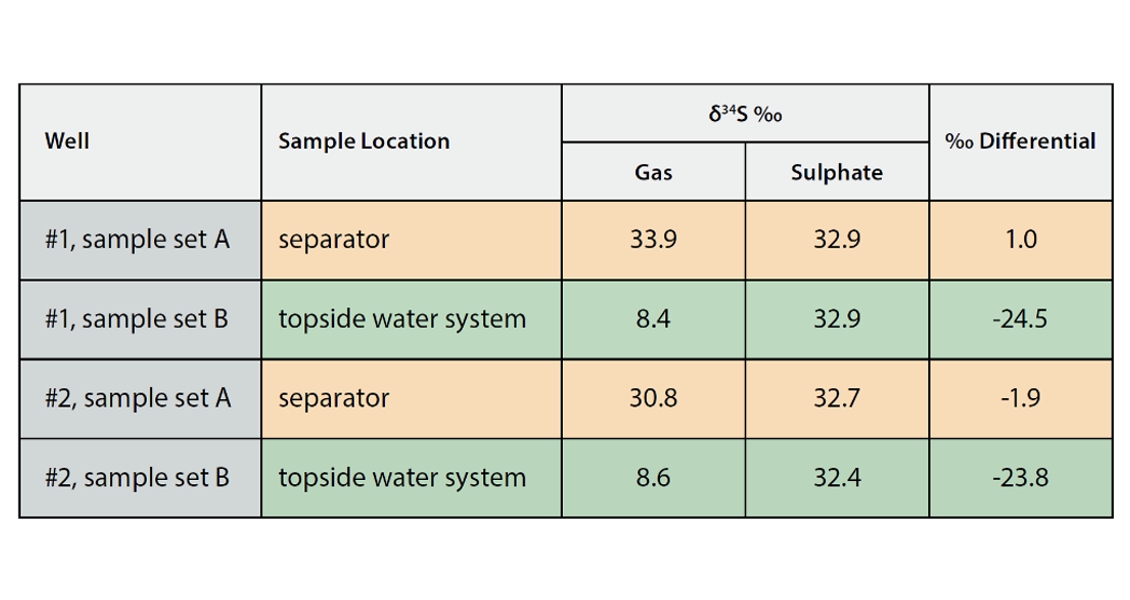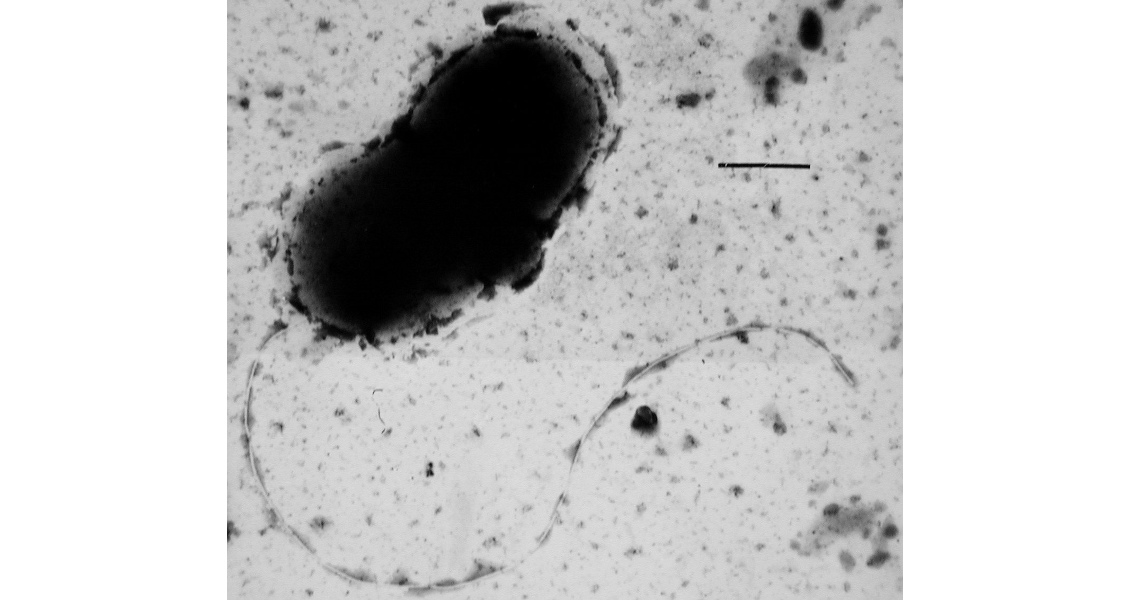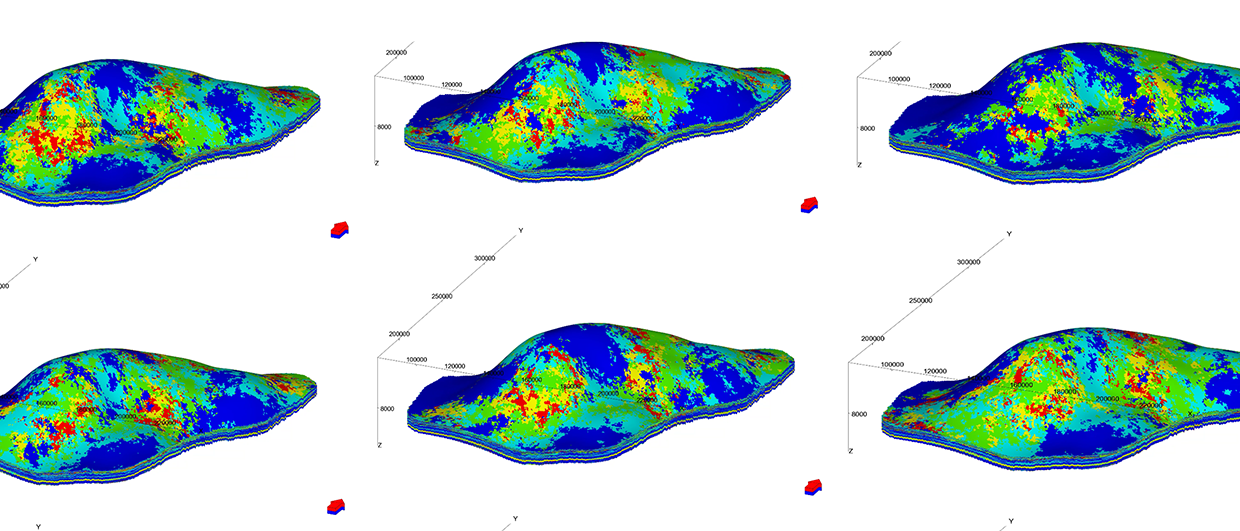Hydrogen sulphide (H2S) is a corrosive and toxic gas that can be present in oil and gas reservoirs as a result of thermochemical reactions in the subsurface, or because of biochemical reactions caused by sulphate-reducing bacteria. The presence of H2S in reservoir fluids (reservoir souring) is highly undesirable, and knowing the source of the gas can guide efforts to prevent or control this unwanted gas.
A Useful Case Study
As oilfields mature they are at increased risk of reservoir souring from microorganisms and this risk increases when water flooding, often practised to help maintain reservoir pressure and to enhance oil recovery, is used. Water flooding and hydraulic fracturing can introduce microorganisms and nutrients into the subsurface, and over time microbial growth can increase and create significant amounts of H2S.
 A platform in the Gulf of Mexico. As oilfields mature, the reservoirs become increasingly subject to reservoir souring due to hydrogen sulphide. (Source: John Kilbane)Periodic monitoring by an oil company of H2S concentrations in gas samples collected at various locations on an offshore oil production platform indicated that H2S was becoming a pervasive problem that was getting worse in wells that had previously not contained detectable concentrations of the gas. The greatest concern was that reservoir souring had occurred and that elevated/increasing concentrations of H2S would continue causing safety and corrosion issues, thus increasing the cost of oil production. The reservoir temperature was about 160°F (70°C), drilling had not employed hydraulic fracturing, and water injection/flooding was not being practised. For these reasons, and because limited microbiological testing indicated no detectable microorganisms, it was initially thought that reservoir souring was not the source of the H2S.
A platform in the Gulf of Mexico. As oilfields mature, the reservoirs become increasingly subject to reservoir souring due to hydrogen sulphide. (Source: John Kilbane)Periodic monitoring by an oil company of H2S concentrations in gas samples collected at various locations on an offshore oil production platform indicated that H2S was becoming a pervasive problem that was getting worse in wells that had previously not contained detectable concentrations of the gas. The greatest concern was that reservoir souring had occurred and that elevated/increasing concentrations of H2S would continue causing safety and corrosion issues, thus increasing the cost of oil production. The reservoir temperature was about 160°F (70°C), drilling had not employed hydraulic fracturing, and water injection/flooding was not being practised. For these reasons, and because limited microbiological testing indicated no detectable microorganisms, it was initially thought that reservoir souring was not the source of the H2S.
Subsequent analysis of sulphur isotopic ratios in H2S samples collected from gas samples from the platform seemed to indicate that the source was microbiological. Preliminary data then seemed contradictory, and it was not clear what the source actually was. A more thorough investigation was authorised that involved the collection and analysis of gas, water, and oil samples from multiple locations. This more comprehensive data set revealed that H2S of non-biological origin was present in some production fluids obtained directly from wellhead and primary separator samples, but H2S of biological origin was also present in many samples obtained from the topside water handling system.
This case study demonstrated that only by obtaining comprehensive data from multiple samples that included H2S quantification, sulphur isotopic ratios in gas and water samples, microbiological data from growth and genetic testing, and water chemistry testing to quantify organic acids was it possible to conclude that there were two sources of H2S in samples from this offshore platform. The oil company now knows that thermogenic H2S is migrating into the oil production reservoir and that the topside water-handling system is vulnerable to microbial contamination, and it can plan accordingly.
Chemical or Biological?
The confusion regarding the source of the H2S resulted from sample collection by field production personnel who were not experienced in reservoir souring, geochemistry, or microbiology. After routine monitoring of gas stream samples revealed detectable concentrations of H2S at a location on the oil platform, the result was confirmed with additional field measurements. Management subsequently requested that the oil production personnel should collect H2S samples using an Isotrap and they should perform additional field measurements of H2S at various locations on the platform. The source of H2S (from chemical or from biological processes) can often be determined by quantifying the amounts of the stable isotopes of sulphur, chiefly 32S and 34S. Chemical processes generally do not discriminate between isotopes, whereas biochemical and microbiological processes have a preference for 32S. Therefore, if a reaction product is depleted in 34S as compared with the starting material, then the reaction can be determined to be biochemical.
The analyses to quantify the various stable isotopes of sulphur require a sufficient mass of H2S, and the Isotrap device is designed to collect the necessary amount. When the Isotrap was placed on the gas outlet of the separator serving the well where H2S had been observed, it failed to completely fill the device over a period of a few hours. However, during that time it was determined that higher H2S concentrations were detected at a nearby location in the water treatment system, which received water from this separator. When the Isotrap was moved to this location it filled quickly and was then sent to the laboratory. The amount of 34S present in this sample was 8.3‰, a value that is relatively low and was interpreted to be possibly consistent with microbiologically produced H2S, fostering concern within the oil company that reservoir souring due to microbial metabolism was occurring. This worrying conclusion, however, was based on two mistakes.
When the data was received it was attributed to separator gas from a specific well, but the individual who collected the sample did not appreciate that knowing the precise location that the sample was collected from was important to the interpretation of results.
The second mistake was not realising that sulphur isotope abundance in various materials in nature can vary considerably, so that merely obtaining data for the sulphur isotopic ratio in a given sample will generally not allow conclusions to be made as to whether a given material originated from chemical or from biochemical reactions. For the microbiological conversion of sulphate to hydrogen sulphide, depletion of 34S in the sulphide has been reported to typically range from -15‰ to -25‰ and this can only be determined by obtaining sulphur isotopic data from the sulphate in the produced water and in the H2S in the gas: both samples should be from the same well.
Moreover, the precise location of any samples collected is important, as was shown in subsequent testing. The data in the table above illustrate that subsequent, more thorough testing documented that there was essentially no change in the sulphur isotopic ratio when H2S samples obtained from primary separator gas samples were compared with values from sulphate in the produced water from these same wells. However, when H2S samples were obtained from topside water-handling system locations downstream from the primary separators, then significant depletion of 34S in the sulphide was observed, which is consistent with microbiological sulphate reduction. Additional testing (data not shown) also demonstrated that organic acids such as acetic acid and propionic acid were present in topside water samples but not in separator water samples. Organic acids are a byproduct of microbial metabolism. Furthermore, microbial growth tests and genetic tests (qPCR or quantitative polymerase chain reaction) documented the presence of acid-producing bacteria, sulphate-reducing bacteria, and other microorganisms in topside water samples but not in separator water samples.
Biological Processes Not Responsible
When all of these data are considered, there is no evidence for microbiological activity in the subsurface creating reservoir souring; however, once the produced water is brought topside it is vulnerable to microbial contamination and the subsequent production of H2S. The source of the thermogenic (chemically created) H2S recently observed in the gas from some wells is unknown, but is presumably due to the presence of a H2S-containing gas/oil/water source that is in communication with the oil-producing zones tapped by these oil wells. Knowing that biological processes are not responsible for the observed H2S in reservoir gases will allow the oil company to take appropriate steps in producing oil from existing wells, and it will influence the future exploration and production activities at this oil field.
As a result of this study biocide has been added to the topside water-handling system at this oil platform, and a programme for the routine monitoring of corrosion-associated microorganisms has been implemented.







